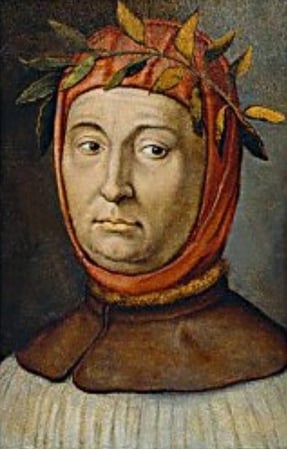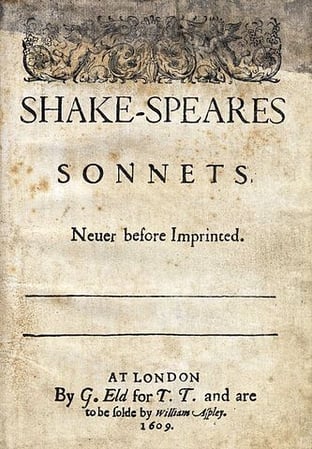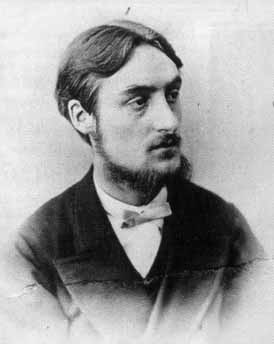When You Read a Poem That Uses a Word for Which There Are Synonyms
You've probable read at least a few sonnets in English language grade, perhaps during a Shakespeare unit. Merely what is a sonnet exactly? Is there just 1 sonnet form? Did Shakespeare invent it? Read on to learn about the history of the sonnet and the diverse qualities that brand upward a sonnet poem, including the traditional sonnet rhyme scheme and meter. Nosotros'll also go over all the major types of sonnets, give you examples, and offering a handful of tips for writing your very own sonnet verse form. A sonnet is a short lyric poem that consists of xiv lines, typically written in iambic pentameter (a 10-syllable pattern of stressed and unstressed syllables) and post-obit a specific rhyme scheme (of which at that place are several—nosotros'll get over this point more than in just a moment). In addition, sonnets have something called a volta (twist or plow), in which the rhyme scheme and the bailiwick of the poem suddenly modify, often to signal a response to a question, a solution to a problem, or the resolving of some sort of tension established at the commencement of the poem. This turn normally happens closer to the cease of the sonnet, though precisely when it appears varies depending on the particular sonnet class. Now, what about the history of the sonnet? Originating in Italy, the sonnet comes from the Italian word sonetto, meaning "little song" or "little sound." The oldest known sonnet form was invented past Italian poet Francesco Petrach in the 14th century. Called the Petrarchan or Italian sonnet, this sonnet structure consists of get-go an octave (eight lines of poesy in iambic pentameter) and then a sestet (6 lines). The rhyme scheme is abba abba; the rhyme scheme in the sestet tin vary a piffling but is typicallycde cde or cdc dcd. Merely it is perhaps famed 16th-century English poet and playwright William Shakespeare who came up with the most well-known and easily recognizable sonnet form. In the Shakespearean or English sonnet, each line is 10 syllables long written in iambic pentameter. The structure tin be divided into three quatrains (four-line stanzas) plus a final rhyming couplet (two-line stanza). The Shakespearean sonnet rhyme scheme is abab cdcd efef gg. Many other sonnet structures have been invented by an array of poets (nosotros'll get over what these are presently). In terms of themes, these days sonnets are most often associated with themes of dearest and romance, though topics such as death, time, and faith are not uncommon. Equally I explained above, the two main types of sonnets are the Petrarchan (or Italian) sonnet and the Shakespearean (or English) sonnet. Before we go over both of these types in more item, let's accept a quick await at some of the key similarities and differences between the ii sonnet forms: Origin # of Lines Iambic Pentameter? Structure Rhyme Scheme Volta Petrarchan Sonnet Italian fourteen Yeah An octave and a sestet abba OR abba abba cdc dcd Betwixt the eighth and ninth lines Shakespearean Sonnet English 14 Aye Iii quatrains and a rhyming couplet abab cdcd efef gg Between the 12th and 13th lines The Petrarchan sonnet is the original sonnet structure developed by Italian poet Francesco Petrarch. To reiterate, here are the primary characteristics of this sonnet course: Allow's look at an example of a classic Petrarchan sonnet. The post-obit poem was written by famed 19th-century English poet Elizabeth Barrett Browning. Sonnet 43, commonly referred to equally, "How Exercise I Love Thee?" follows the Petrarchan sonnet rhyme scheme of abba abba cdc dcd: Sonnet 43 past Elizabeth Barrett Browning How do I love thee? Let me count the means. (a) In this highly romantic Petrarchan sonnet, the speaker is enumerating the many ways she loves someone. The octave stresses the extensive love she has for this person, while the final sestet—where the volta appears—presents a subtle comparison between the speaker's present passions and "old griefs," or prior struggles in life. The Shakespearean sonnet is arguably the near famous sonnet form and was developed by William Shakespeare, who wrote more than 100 sonnets using this construction. Hither are the main characteristics of the Shakespearean sonnet: Now, let's have a look at a particularly well-known sonnet written by William Shakespeare: Sonnet 18, or what is more commonly referred to as "Shall I Compare Thee to a Summer's Day?" Sonnet 18 by William Shakespeare Shall I compare thee to a summer'south day? (a) This eloquently written poem perhaps best encapsulates the Shakespearean sonnet grade. Here, Shakespeare compares the transient dazzler of a young man to a tranquil, warm summertime day. The volta, as nosotros know, appears in the final rhyming couplet and is the point at which Shakespeare confidently declares the young man's youthful beauty will forever live on—evenlong afterwards he dies—through these very words. While the Petrarchan and Shakespearean sonnet forms are indisputably the well-nigh famous and virtually pop kinds of sonnets, several other sonnet structure typesdo exist. These include the post-obit, each of which nosotros'll get over in more detail below: The Spenserian sonnet is a sonnet form named for 16th-century English poet Edmund Spenser, who introduced this structure in his 1595 drove of sonnets titled Amoretti. The Spenserian sonnet is extremely similar to the Shakespearean sonnet. The main difference is the rhyme scheme: whereas the Shakespearean rhyme scheme introduces a new rhyme in each quatrain, the Spenserian sonnet carries over the latter rhyme from the previous quatrain in a concatenation rhyme: abab bcbc cdcd ee. Like both the Petrarchan and Shakespearean sonnets, Spenserian sonnets are commonly written in iambic pentameter. Hither is an example of a Spenserian sonnet, written past Edmund Spenser himself. Sonnet Three is taken from Spenser's Amoretti: Sonnet Iii (Amoretti) by Edmund Spenser The sovereign dazzler which I exercise admire, (a) The Miltonic sonnet was named for 17th-century English poet John Milton, who is all-time known for his ballsy poem Paradise Lost. While this sonnet form is mostly the aforementioned as that of the Petrarchan sonnet (information technology uses the Petrarchan rhyme scheme of abba abba cde cde), Miltonic sonnets apply enjambment to offer a more compact, interconnected presentation of the thoughts being expressed. (Enjambment is when a sentence, thought, or phrase continues across a line in poetry without pause.) Another key deviation betwixt the two sonnet forms is theme: Petrarchan sonnets tend to focus on love and romance, whileMiltonic sonnets are frequently about faith or political/social matters. The following Miltonic sonnet, titled Sonnet 19 or "When I Consider How My Light Is Spent," is i of Milton's about famous sonnets: Sonnet xix by John Milton When I consider how my light is spent, (a) The terza rima sonnet is named for a poetic convention called terza rima, which is a three-line stanza that uses a concatenation rhyme (the carrying over of the rhyme used in a previous stanza). The rhyme scheme of the terza rima sonnet is aba bcb cdc ded followed by a rhyming couplet that usually echoes the first rhyme of the poem: aa. Here is an example of a terza rima sonnet written by renowned American poet Robert Frost. The poem is titled "Acquainted With the Dark": "Acquainted With the Night" by Robert Frost I have been ane acquainted with the nighttime. (a) I have looked downward the saddest city lane. (b) I have stood nonetheless and stopped the audio of anxiety (c) But not to call me back or say skilful-goodbye; (d) Proclaimed the time was neither wrong nor right. (a) The curtal sonnet is a shortened, or curtailed, version of the sonnet invented by 19th-century English poet Gerard Manley Hopkins. Unlike the majority of sonnets, the curtal sonnet does non strictly abide past the 14-line dominion; rather, it maintains the overall proportions of the Petrarchan sonnet by contracting two quatrains in the octet into 2 tercets (iii-line stanzas) and the concluding sestet into a quintet (five-line stanza). The terminal line of the quintet (and the sonnet equally a whole) is much shorter than other lines and is called a "tail" or "one-half-line." As a result, the curtal sonnet can be described equally beingness either 10.5 or 11 lines long. The curtal sonnet rhyme scheme is abc abc followed by dbcdc or dcbdc. What's more, this sonnet formuses a type of meter chosen sprung rhythm, which differs from iambic pentameter in that each line starts with a stressed instead of unstressed audio and (usually) contains four stressed syllables. One famous curtal sonnet written past Hopkins is "Pied Beauty." This sonnet uses a rhyme scheme of abc abc dbcdc: "Pied Beauty" by Gerard Manley Hopkins Glory be to God for dappled things— (a) Now that we've answered the question, "What is a sonnet?" and explained the chief variations of the sonnet poem, it's fourth dimension to endeavour writing one for yourself! In this section, we'll requite you our six all-time tips for writing a smashing sonnet. The first stride to writing a nifty sonnet poem is to get more acquainted with sonnets and their characteristics as a whole, including how they sound in terms of both rhythm and rhyme, what kinds of themes and subjects they focus on, and what types of volta they utilize. You could start by browsing some of the virtually famous sonnets by Shakespeare and Petrarch, for case, especially if you're interested in writing a more traditional sonnet. Another choice is tosearch for sonnets in online databases, such equally Poets.org. On this website, y'all tin can search for a specific sonnet or poet, or browse all available sonnets by choosing "Sonnet" nether "Forms" and letting the folio load. I recommend reading several sonnet forms (non simply Shakespearean!) so you can become a better feel for the sonnet construction y'all like best and would prefer to use for your own sonnet. Once you've gotten more than familiar with the various sonnet structures, it's fourth dimension to recollect of possible topics and themes you could write about in your sonnet verse form. Traditional sonnets are love poems, just you shouldn't feel limited to romance. Many people accept written sonnets that discuss things such as religion, social or political matters, tensions or bug, mundane situations, etc. Yous don't even accept to choose a serious subject —it could be a sarcastic or ironic sonnet if y'all then wish! Ultimately, the topic you desire to write about in your sonnet is entirely upwardly to you. Once you take an idea for what you lot desire to write almost, you lot'll want to start seriously considering the sonnet form you believe will best fit the vision you have for your sonnet poem. For example, if you lot strongly adopt poems that don't have as many pauses and sound a lot more similar dialogue, the Miltonic sonnet construction would exist a solid choice due to its use of enjambment. Or, if you find it hard to write 14 rhyming lines, the curtal sonnet might be a skilful sonnet form to try working with. If you lot're not sure which sonnet structure you want to use, try your hand at starting a few dissimilar forms to meet which one seems to come more naturally to yous and to the poem itself. A huge part of sonnets is being able to use words that rhyme (or more often than not rhyme, as nosotros'll hash out more in the side by side tip). This tin be pretty difficult, specially if you're sticking with the traditional iambic pentameter meter. If you lot ever get stuck or just want to browse possible words that share a sure meaning, use a thesaurus. Many online versions exist; I suggest using Thesaurus.com or the Merriam-Webster Thesaurus. A thesaurus will non only aid you find words that better fit the topic, meter, and rhyme scheme of your sonnet poem, but volition also improve your vocabulary so that you won't take to rely equally much on a thesaurus in the future when writing a sonnet. Many people call back they have to discover perfectly rhyming words in lodge to write a adept sonnet, but this isn't necessarily true. Although sonnets do typically have a strict rhyme scheme—whether that's the Petrarchan rhyme scheme, the Shakespearean rhyme scheme, or something else— many sonnets use words that are NOT perfect rhymes. For instance, permit's expect dorsum at the first four lines in Browning's "How Do I Dear Thee?": How do I beloved thee? Let me count the means. (a) Because this sonnet uses the Petrarchan rhyme scheme, "ways" should rhyme with "grace," but by sounding out these two words, we can immediately tell that they aren't really perfect rhymes. The "due south" audio in "ways" is more like a "z" audio and clearly differs from the "southward" audio pronounced at the terminate of "grace." This type of rhyme is called an assonant rhyme in that while the vowels are the aforementioned (that "ay" sound in the heart of both "ways" and "grace"), the consonants are different. Another rhyme y'all could use in your sonnet poem is a consonant rhyme in which the vowels are different just the consonants are the same (e.g., brawl and bell, faith and death). The bespeak hither is that although rhyming is an of import part of the sonnet course, this rule, besides, can be bent to meliorate fit the overall image you wish to paint. Our final tip is to be brave when writing your sonnet verse form—don't be afraid to mix things up! Fifty-fifty though the traditional sonnet structure follows a strict pattern in its meter and rhyming, you don't need to follow whatever of these if you and then choose. More often than not speaking, poetry welcomes rule-breaking and creativity, then experience free to attempt to come up with your own sonnet form or means to amend upon the traditional sonnet structure. For example, you could develop a new rhyme scheme or endeavour out meters other than iambic pentameter. Simply remember that if you change the sonnet class likewise much, information technology might not be identifiable every bit a sonnet anymore, and then think nigh whether that's a risk you're willing to take. Every bit we've seen, there isn't a simple answer to the question, "What is a sonnet?" A sonnet can inhabit many different forms depending on things such equally the rhyme scheme, length, and meter used. In general, though, hither are the master characteristics that define most sonnets: The major sonnet forms are the Petrarchan (Italian) sonnet and the Shakespearean (English) sonnet. Other sonnet forms include the Spenserian sonnet, the Miltonic sonnet, the terza rima sonnet, and the curtal sonnet. Writing a sonnet verse form entails a lot of training. Once once again, here are oursix tips for writing a fantastic sonnet: Now, leave there and start reading (and writing) some sonnets! What is iambic pentameter exactly? This guide explains what the nearly common poetic meter is and how you, likewise, tin write a poem using it. Whether you lot're writing a sonnet poem or a story, yous'll likely want to utilise some literary devices to make your writing stand out. Learn how imagery tin bring color to your writing and get a vast list of 100+ words y'all can utilise to set the tone of your story. What is personification? Become all the info you need on this useful literary device with our guide.
What Is a Sonnet? Overview & History
Petrarchan vs Shakespearean: The 2 Main Sonnet Forms
abba
cde
cde  Portrait of Francesco Petrarch
Portrait of Francesco Petrarch Petrarchan Sonnet
I dear thee to the depth and latitude and acme (b)
My soul can reach, when feeling out of sight (b)
For the ends of being and platonic grace. (a)
I love thee to the level of every 24-hour interval's (a)
Almost quiet demand, by lord's day and candle-low-cal. (b)
I dear thee freely, every bit men strive for right; (b)
I beloved thee purely, every bit they plow from praise. (a)
I love thee with the passion put to use (c)
In my old griefs, and with my childhood'south organized religion. (d)
I love thee with a honey I seemed to lose (c)
With my lost saints. I love thee with the breath, (d)
Smiles, tears, of all my life; and, if God choose, (c)
I shall but beloved thee better after decease. (d)  Title page for Shakespeare'south sonnet collection, start published in 1609
Title page for Shakespeare'south sonnet collection, start published in 1609 Shakespearean Sonnet
One thousand art more than lovely and more temperate. (b)
Rough winds exercise milk shake the darling buds of May, (a)
And summer's lease hath all too short a engagement. (b)
Sometime too hot the eye of heaven shines, (c)
And often is his golden complexion dimmed; (d)
And every off-white from fair sometime declines, (c)
By chance, or nature's irresolute course, untrimmed; (d)
Simply thy eternal summer shall non fade, (e)
Nor lose possession of that fair k ow'st, (f)
Nor shall death brag m wand'rest in his shade, (e)
When in eternal lines to Time m abound'st. (f)
So long every bit men can exhale, or eyes can see, (g)
So long lives this, and this gives life to thee. (g) iv Boosted Forms of the Sonnet Verse form
 Portrait of Edmund Spenser
Portrait of Edmund Spenser Spenserian Sonnet
Witness the world how worthy to exist praised: (b)
The light whereof hath kindled heavenly fire (a)
In my frail spirit, past her from baseness raised; (b)
That being at present with her huge effulgence dazed, (b)
Base affair I tin no more than endure to view; (c)
But looking still on her, I stand amazed (b)
At wondrous sight of and then celestial hue. (c)
So when my tongue would speak her praises due, (c)
It stopped is with thought'south astonishment: (d)
And when my pen would write her titles true, (c)
It ravish'd is with fancy's wonderment: (d)
Notwithstanding in my heart I so both speak and write (east)
The wonder that my wit cannot endite. (e)  Portrait of a immature John Milton
Portrait of a immature John Milton Miltonic Sonnet
Ere half my days, in this dark world and wide, (b)
And that one Talent which is decease to hide (b)
Lodged with me useless, though my Soul more aptitude (a)
To serve therewith my Maker, and present (a)
My true account, lest he returning chide; (b)
"Doth God exact day-labour, calorie-free denied?" (b)
I fondly ask. Merely patience, to prevent (a)
That murmur, presently replies, "God doth non need (c)
Either man's work or his own gifts; who all-time (d)
Bear his mild yoke, they serve him best. His state (e)
Is Kingly. Thousands at his bidding speed (c)
And mail service o'er Land and Ocean without rest: (d)
They besides serve who only stand and await." (eastward) Terza Rima Sonnet
I accept walked out in rain—and dorsum in rain. (b)
I have outwalked the furthest metropolis light. (a)
I have passed past the watchman on his beat (c)
And dropped my eyes, unwilling to explicate. (b)
When far away an interrupted cry (d)
Came over houses from another street, (c)
And further still at an unearthly elevation, (a) / (due east)
One luminary clock against the sky (d)
I have been one acquainted with the nighttime. (a)  Gerard Manley Hopkins
Gerard Manley Hopkins Curtal Sonnet
For skies of couple-colour as a brinded moo-cow; (b)
For rose-moles all in stipple upon trout that swim; (c)
Fresh-firecoal chestnut-falls; finches' wings; (a)
Landscape plotted and pieced—fold, fallow, and turn; (b)
And áll trádes, their gear and tackle and trim. (c)
All things counter, original, spare, strange; (d)
Whatever is fickle, freckled (who knows how?) (b)
With swift, irksome; sweet, sour; adazzle, dim; (c)
He fathers-forth whose dazzler is past modify: (d)
Praise him. (c) How to Write a Keen Sonnet: vi Tips
#ane: Read Lots of Sonnets
#2: Remember of a Topic
 Y'all can write about annihilation for your sonnet—even this adorable play a joke on!
Y'all can write about annihilation for your sonnet—even this adorable play a joke on! #iii: Choose a Sonnet Class to Follow
#4: Befriend a Thesaurus
#5: Don't Worry Near Rhyming Words Perfectly
I love thee to the depth and breadth and height (b)
My soul tin reach, when feeling out of sight (b)
For the ends of being and ideal grace. (a) #6: Don't Exist Agape to Mix Things Up
 Ofttimes, the gamble is worth the reward.
Ofttimes, the gamble is worth the reward. Key Takeaways: What Is a Sonnet?
What's Adjacent?

Virtually the Author
Hannah received her MA in Japanese Studies from the University of Michigan and holds a available'due south caste from the University of Southern California. From 2013 to 2015, she taught English in Nihon via the JET Program. She is passionate virtually educational activity, writing, and travel.
Source: https://blog.prepscholar.com/what-is-a-sonnet-poem-form
0 Response to "When You Read a Poem That Uses a Word for Which There Are Synonyms"
Post a Comment